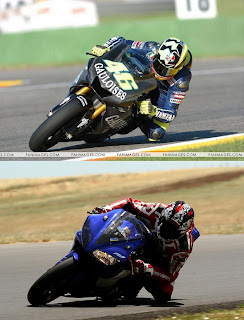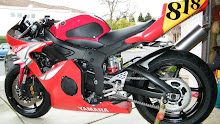"Six months prior to the 2000 Summer Olympics, Wilkinson suffered a serious foot injury that kept her out of action for a couple of months. During this time, she used mental images to visualize her dives. Her foot was not fully recovered by the time she started diving again, but she was able to qualify for the Olympics. At the 2000 Summer Olympics, Wilkinson, who was still in pain from her foot injury, was in eighth place after the first of five dives in the platform diving finals. However, she earned her the first gold medal for a female American platform diver since 1964."
- Wikipedia entry for Olympic Diver Laura Wilkinson
The true story above is one that I will never forget, if not just for the mere fact that I always fall back on it during applicable situations.
You look where you want to go.
Also another adage in my book of self-motivations and learning tools. A bit of a racing nugget describing the phenomenon that regardless of the mechanics, your body will lead you to what you are looking at. Riders are taught this for a couple of reasons; to make a corner even in doubt, and more importantly, to not hit a wall (or anything!) if you don't want to (unless they want to!).
At the height of my track riding addiction, when I could average a bit more than doing a trackday once a month or so, I had all the opportunities to practice the sport-riding around a track for the sake of honing it. There is no substitute for actual on-track experience when you are trying to learn the dynamics of piloting a motorcycle, especially with regards to body position, which is a significant tool in a rider's repertoire to be able to control a motorcycle at speed. You could put your motorcycle on stands to stabilize it, then move, pivot, and pitch yourself all over the motorcycle in trying to burn to muscle memory what your proper body position ought to be, but the properties of a static motorcycle changes at speed, therefore so would your interaction with it.
Then came my self-imposed regulation, when I decided, for the sake of not getting sick of what I love doing, to do less trackdays. I think I've been successful in implementing this regulation every year for the past couple of years or so now. This year alone, I've only done four trackdays to date. This is fantastic in the sense that I still love the sport, I spend less, and the chances of having on-track incidents have decreased as well. Unfortunately, the other casualty was sacrificing a bit of my never-ending quest to get better and better through practice. I've always used every street-riding that I do as something to hold me over in between my trackdays, but as I wrote earlier, the dynamics of motorcycle riding changes at speed; you don't ride the street like you would the track, and vice versa. The basics are the same, which at the very least is what I retain and burn to muscle memory, but the physical and mental sensations differ between the two, and greatly determine one's inputs on the bike.
So what else did I do to keep me relatively sharp and progressing, even when not doing?
Visualization.
There are a lot of professional motorcycle racers I admire, each and every one of them having something distinct in their ability to make a motorcycle go around a racetrack fast, from a MotoGP god like Casey Stoner, to local AFM hero Dave Stanton. Even if reality dictates I could never amount to a tenth of what they are now, they still make the best examples for me to try and emulate as far as riding abilities go. Now out of the number of them I could've used, I chose Valentino Rossi. His riding style seemed the most natural and relaxed, looking as if it's not hard work to make the machine go fast, exuding comfort and thus total control over his machine. The way Rossi rode a motorcycle, it looked like how a person ought to ride a motorcycle if a rider had nothing else but natural instinct to go by; no unnecessary contortions, no wasted physical effort. Just sheer efficiency.
So I found one photo of Rossi taking a corner, which is the photo depicted below. Numerous times I would look at the photo, pulling it onto my monitor at random times of the day just to stare at it, to imagine what he must have thought of (if he even thought about it) to make his body move the way it did to look the way it would; how he bent his arms, upper body, legs, etc. I tried to imagine how he anchored himself, what muscle(s) were taking the load, and which were featherweight in comparison. I tried to visualize his point of view, of how the road ahead of him would look or how much the horizon would tilt in correlation with how much he tilted his head from his shoulders.
More or less I would imagine, "what would it feel to do that?"
It didn't happen overnight, and it probably happened over tens if not hundreds of times I clicked that image file to open and view it. Admittedly, I eventually stopped (or maybe forgot) looking at the photo for awhile now, but I guess it really stands that if you keep looking at something, even previously, something eventually burns itself to (muscle) memory.

Valentino Rossi up top, just some random poser trying
to look like him on the bottom.
You see*?
I can still pick out a number of things that I do differently from my model image, but maybe if I go back to glazing over Rossi's photo again, I may just completely plagiarize the man himself.
As apparent, you look at something enough times, and you will find yourself there. :)
* Pun most definitely intended!















